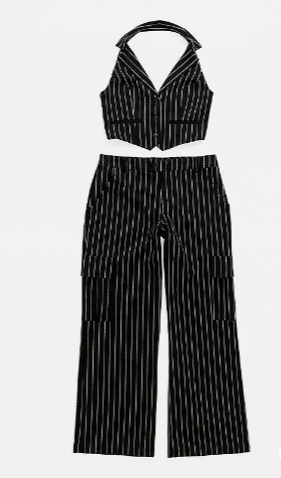The Croft Magazine// By Theano Dimopoulou, Third Year, Psychology in Education
Theano Dimopoulou takes a look at the 'then and now' of power suit dressing.
Is it possible for a woman’s clothes to make her feel more powerful? The power suit was designed to give women an energetic and strong appearance. The intersection between conservative patriarchy and female boldness. A traditionally male-dominated piece of clothing can be what every powerful, modern woman needs to showcase her true power and character. In this article will take a look at the origin history and the future of the power suit.
The first appearance of the power suit was introduced in the 1920’s by Coco Chanel. That’s where it all started. While Chanel might remind people of a cool traditional femininity and the signature pink perfume bottle, the designer was the first that took masculine designs and transformed them for women. Women were required to wear corsets, and Coco gave women air, by presenting a set with jacket and a skirt, using comfortable materials allowing them to breathe. At the time, women started to enter the job market and the new design was name “the new woman’s uniform”. Then came the change to a more androgynous look, with wider shoulders and straight lines in clothes. A more tom-boy look was created. Katherine Hepburn proved that a more masculine fit could be sexy and feminine. A few years later, the pantsuit was introduced. the recognisable aggressive power suit of the 1980s exists only because of designer Marcel Rochas. She introduced wide shouldered suits and a more masculine cut to female clothing. Similar to the effort of Coco Chanel the masculine, white shouldered cut was an effort to reflect women's needs to showcase their character outside of the home.
A crucial part of the power suit history, takes place in 1966 when Yves Saint Laurent introduced le smoking, designed specifically for women. Its name nods to the 19th century meant smoking jacket, taking their name because of the silk lapels and their design, that allowed any ash falling from after dinner cigars to slide off, keeping the men clean. The comparison between a men’s smoking jacket and the idea of a classically male drinking and smoking individual to a working woman being able to pull off a similar article of clothing, is the reason why this idea was so revolutionary for its time. A lot of criticism was placed on the brand, as a lot of people believed that women should not be able to take something so elegant and masculine and adapt it to a more feminine nature. Even after all the criticism le smoking kept its place in a lot of future collections by Yves Saint Laurent, and is now considered one of the most recognisable pieces of fashion.
In 1970 things began to change. The suit represented a serious woman, as more and more women were entering the workforce and invading the “boys club”. the shoot worked as their symbol as approved, they were just as serious and capable as the men working next or with them. Shira Tarrant, A professor and author of Fashion Talks: Undressing The Power Of Style, supports that: “Wearing a pantsuit was the expectation at the time if you were to be taken seriously as a businesswoman, but women were still criticised for trying to emulate men, because it was a derivative of menswear.” Combating the traditional and strict male attire that is connected to a work and business environment, during the 1970s women, introduced what they called the 'Annie Hall' clothes. These women were carefree and fought against society's gender ideals by wearing men clothing in a plain, everyday style. This is an example of the power women had over men's clothing at the time and their efforts to be fairly integrated into the business and everyday life of working men. Using business clothing as an everyday, plain outfit was a show of confidence at a time where women weren't allowed in restaurants were in trousers.
The peak time for women power suits was during the 1980s, when the show dynasty was putting shoulder pads back on the map, a well-known designer was trying to figure out ways to use a masculine shoot for a woman’s unmasculine figure. His name was Giorgio Armani and she managed to completely revolutionise women's fashion, showcasing the serious career women that began to rise. His new tailored trouser or skirt suits took the gender out of fashion and gave it a much needed seriousness. That didn't rule out the possibility that these pant and blazer combos were attempting to emulate a more masculine presence. It was a hazy period, one in which women had power but had to hide behind pinstripes. These big, shouldered jackets and pants disguised a woman's figure and took the focus off her gender, creating a feeling of authority as the traditional sex roles continued to blur.
Today, women's fashion in the workplace is pretty much fully immersed- the need for strict blazers and heels isn't there as strictly anymore. Anna Wintour, Editor-in-Chief of Vogue since 1988, can be described as one of the most influential women and fashion icon, and she's rarely seen in a traditional power suit. She is seen wearing elaborate patterns and prints. At the same time, women still choose to wear power suits, such as former presidential nominee Hillary Clinton. She views the versatility and simplicity of suits as a 'uniform' that allows her to both fit in with her counterparts but also as a woman running for president, it equips a 'visual cue', that translates her difference to men but also her familiarity to them.
So, looking at the entire history of the power suit and the people that played a crucial role in its development and change, as well as the shift in need of a distinct powerful clothing for women in the workplace in current times, it is important to think about the future and whether, as a society we can overcome gender roles and allow women to feel powerful and influential regardless of their clothing.
Get the look for Elise's power suit!

Featured Image: Epigram/Elsie King









